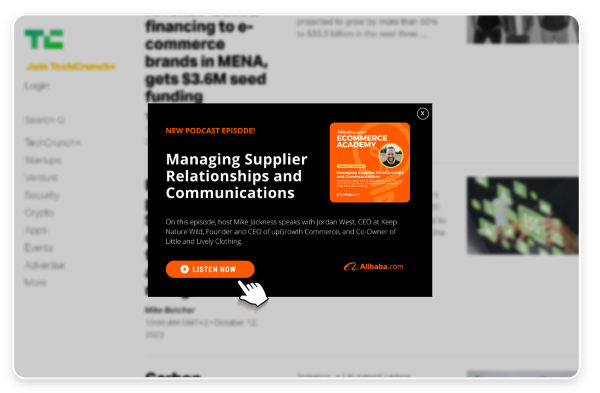
Show notes:
Timestamps
1:48 How to leverage owned media
4:25 How to get internal buy in to leverage owned media
7:10 Paid media
8:08 ContentAllies Listen Network
9:18 The right paid marketing channels for B2B podcasts
12:20 The economics of CLN (CPM, cost per verified listen)
19:12 How do SMB and enterprise B2B podcast goals differ?
22:32 Keywords rankings and Podcast Visibility Optimization
24:14 The specifics of B2B analytics
Key ideas:
How to leverage owned media
– Content Allies is a B2B podcast production agency that works with Meta, Alibaba and other major clients.
– They managed to exceed Meta’s download target by a factor of 7x just by leveraging owned channels; no paid marketing was involved.
– When working with B2B clients, the first thing they look at is: what is their owned media: social channels, newsletter, and website.
– Surprisingly, owned media is a low-hanging fruit that a lot of enterprise shows don’t leverage.
– In Jake’s experience, newsletters are the most effective form of owned media for podcast promotion. They convert better to listeners and subscribers.
– Pairing with PR department is also a great tip to get more exposure. Ask them if the episodes tie to any coming press release.
– One of the challenges of working with large companies is that you need to coordinate with several departments that each have their own processes.
– With so many moving parts, it can be hard to keep momentum and get analytics to measure the impact.
How to get internal buy-in to leverage owned media
– Pre-chew work for all stakeholders to reduce friction as much as possible.
– Don’t dump a giant folder on them expecting them to retrieve the information. Instead, deliver exactly what they need and not more.
– Example 1: when getting the person in charge of YouTube to upload the video version of the episode, send them an email with the link to the video file, the title, description and recommended tags.
– Example 2: when getting the person in charge of social media to post on LinkedIn, send them an email with the link to the video file, the post copy, recommended tags and accounts to tag.
– Example 3: sending the guest an email with a list of things they can do to promote, links to clips and pre-written post copy.
Paid media
– They only launch paid marketing campaigns once they have maxed out the potential of owned media channels.
– With some large clients, getting the teams to give the podcast exposure through owned media is almost impossible. In this kind of case, they resort to paid media earlier than they normally would.
– One of the biggest benefits of paid media is that it’s very predictable: you know you can hit your download target for a given cost per download.
– They had mixed results with podcast-to-podcast promotion for B2B.
– As a business, if you’re going to run ad on podcasts, it makes more sense to promote your product directly rather than your podcast.
The Content Allies Listen Network
– It’s a specialized ad network for B2B podcasts.
– It shows a banner ad on websites and uses contextual advertising (i.e., based on keywords on the page). It works in a similar way to the Google Display Network.
– They get a lot of data on listening behavior (plays, 60-second listens).
– CALN advertisers only pay for verified listens (60 seconds or more).
– The cost per verified download is one thing, but you should always keep quality in mind. You can get incentivized 60-second listens for 10¢ a pop but these users are just interested in their game reward, and the quality is terrible.
– In the future, they will test embedding an Apple podcasts player, so the listen count towards prop up your podcast authority and thus your on-platform visibility.
– The placement has secondary CTAs (call to action): subscribe on Apple, Spotify. All clicks are counted and reported on.
Here’s how a CALN placement looks like in the wild:
How do SMB and enterprise podcast goals differ?
– SMB podcasts: there’s an element of thought leadership, but it’s mostly focused on ABM (account based marketing). They want to drive sales or retention, often by interviewing prospects and existing clients.
– Enterprise podcasts: they tend to be much more focused on thought leadership.
– Thought leadership as a goal can be dangerous because it’s vague and hard to quantify and report on.
– What ContetnAllies does instead is approaching each episode with an objective in mind
Examples of episode objectives:
– Tell customer stories
– Recruitment (example: what is means to be a solutions engineer at Meta?)
– Supporting product launches/product adoption
– Developing partner relationships
– Sales enablement
Keywords rankings and Podcast Visibility Optimization
– The show title is very important
– It can be tough to make big clients change the name of their show if they already have one for different reasons (branding, host egos, etc.). A good solution is too add a secondary title after a hyphen.
– They use Voxalyze to report on keyword ranking progress to their clients.
The specifics of B2B analytics
– Clients like to know for which companies their listeners work for
– ContentAllies works with a tool named Cohost. Cohost enriches IP data with ClearBit.
Resources:
Tools mentioned:
– Voxalyze (sign up for a free trial)
– ContentAllies Listen Network (like Google Display Ads, but for podcasts)
– CoHost
Content mentioned
Podcasts mentioned:
– A Guide to B2B Podcasting (Apple Podcasts)
– A Guide to B2B Podcasting (Spotify)
